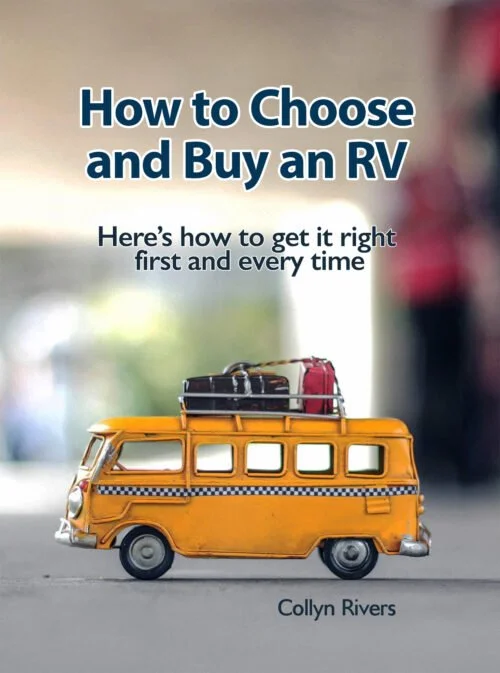by Collyn Rivers
Motorhome and trailer tyres
Motorhome and trailer tyres take a far greater beating than those in general use – an industry report noted that such tyres are subject to major abuse greater than any other form of use. In particular, stated the report, caravan and motorhome tyres are often grossly under-inflated and overloaded.
The best general usage motorhome and trailer tyres for use in Australia are LT (Light Truck) tyres. Be aware though that their heavier construction does not enable them to carry a heavier load. It enables them to run at or near their maximum load at all times.
The maximum load that a tyre can legally carry is a function of heat build-up. It is also speed-related. That heat build-up is greater with light truck tyres. Their thicker side-walls and tread support generate more heat as they flex. To minimise this they must be inflated to pressures higher than for the equivalent passenger tyres.

This tyre has either been grossly overloaded and/or underinflated. Pic: original source unknown.
Current trends
The current trend is toward larger rim diameters, lower tyre side-walls and greater widths. More extreme examples resemble ultra-wide bicycle tyres. There are various reasons for this. Increased rim diameter enables better brake cooling and/or creates space for larger diameter brakes. The low, wide profile provides more responsive handling and more precise steering. It also reduces side-wall flexing and hence heat build-up. As less energy is lost in heat and rolling drag reduced, less fuel is used. With these tyres, having the right tyre pressure is particularly important.
Caravan and motorhome tyres pressure also profoundly affects on-road behaviour, in particular the ratio of tyre pressures front/rear. This is too complex a topic to discuss here – but it is covered in-depth in my article Caravan and Tow Vehicle Dynamics.
Except for extreme off-road going (rock-hopping) tyres with normal on-road tread patterns are fine for dirt road use. They are actually better in the sand. I once drove a 1940 QLR seven tonne Bedford twice the length and breadth of Africa. This included two full Sahara crossings. The truck had standard 1100 by 20 London bus tyres. If interested see Last Drive Across Africa.
Pressures to use
Those caravan and motorhome tyres that are wide and of low profile run at pressures in excess of 750 kPa (over 100 psi). This is needed to maintain their profile and prevent their on-road footprint collapsing. This is (2016) still a problem in that many service stations compressors pump only to 530 kPa (77 psi). If travelling outside city areas buy a tyre compressor capable of doing this reliably with big tyres. If caught out, limit your speed to 65 km/h until you are able to have the tyre correctly inflated. Any major pressure difference seriously prejudices handling (especially in emergency situations).
Wide tyres improve on-road handling but are less effective in sand etc than high profile tyres. Tyre flotation is mainly a function of the length (not width) of the tread’s ‘footprint’. High profile tyres (such as 750 x 16s) extend that footprint length at low pressures. Low profile, wide tyres swell out sideways at low pressures but at far too high a level to be of any value in sand etc. Worse, they form a V shape that causes them to dig in.

Tyre footprints usefully lengthen as pressure is reduced. Pic: Peter Wright.
For dirt road use, lower caravan and motorhome tyres pressure by 20%-25%. Keep speed below 80 km/h to limit destructive heat build-up. Lower pressure also reduces the risk of a blow out when you hit a rock. The tyre ‘folds around’ it. (At full pressure tyres resist distortion. Rocks may punch through them on impact).
Makers’ recommend tyre pressures now allow for heat build increase in pressure of 4%-5% so they should only be adjusted when cold. They are thus slightly under-inflated but attain their correct pressure after 10-15 minutes driving. Do not lower them.
Knowing on-road weight
Correct caravan and motorhome tyre pressures are related to on-road weight. Caravan and motorhome weight varies with loading. The only reliable way to know that weight is (when fully laden and with water tanks full) to take the vehicle to a Certified Weighbridge and check individual axle loadings. If you advise the weighbridge operator beforehand that you do not need a Certified weight it usually costs less. Some do it free of charge. You must also add the weight of yourself and passenger/s plus all you intend to carry. Then ask the tyre maker’s technical department what pressure to use. (Do not attempt to guess the weight of personal effects, books, food etc – people who do tend to underestimate by at least 100 kg (220 lb), and often twice that).
Further information
This issue is also covered in depth in the 2nd edition of the author’s The Camper Trailer Book. It is also covered in depth in my Caravan & Motorhome Book.
If you liked this article Caravan & Motorhome Electrics, you are likely to also enjoy my books. Apart from the above, there are Solar That Really Works (for cabins and RVs) and Solar Success (for home and property systems). All are written from personal experience and in plain down to earth English. The author is an ex motor industry research engineer who switched careers mid-life to become a technical writer/editor and publisher.

